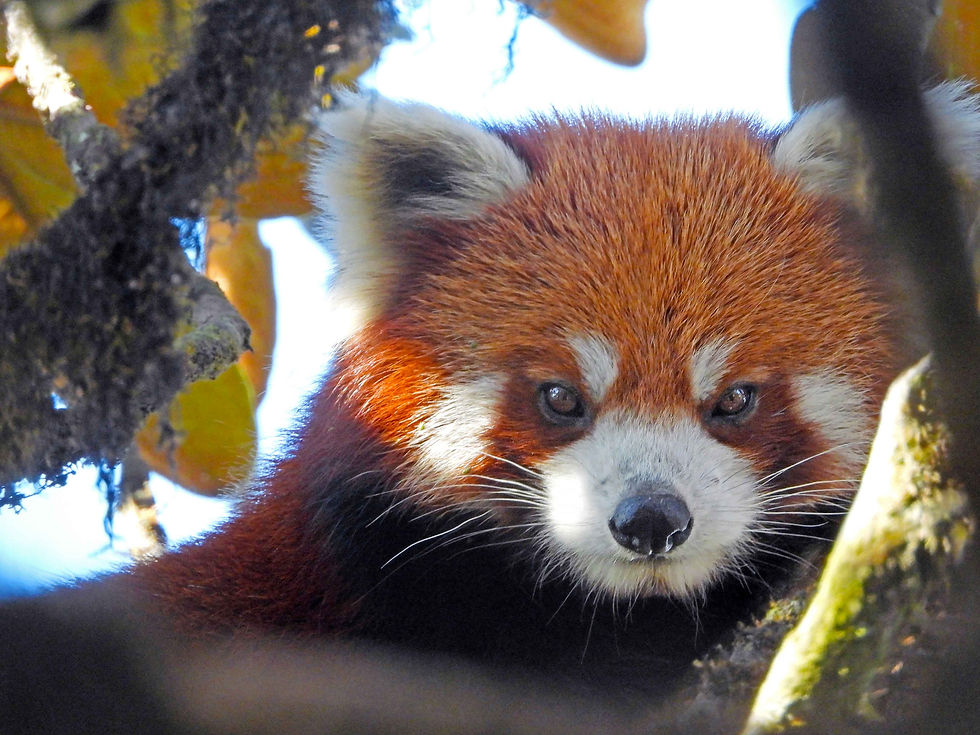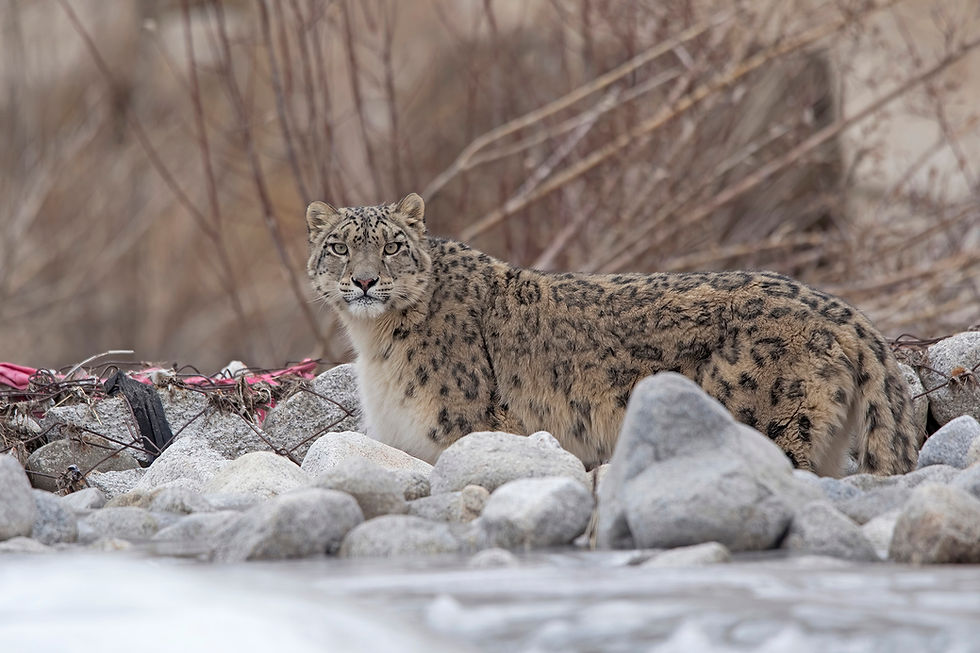An Insight into the Ladakh Snow Leopard Expedition
- Surya Ramachandran
- Jul 6, 2022
- 6 min read

Ladakh, the Indian trans-Himalaya, is one of the last bastions of Tibetan Buddhism in the 21st century. With its richness of history, culture and landscapes, it has become a happy hunting ground for visitors of every stripe – from tourists ticking off exotic destinations, seekers of spiritual bliss, thrill seekers aboard motorcycles or rubber rafts, adventurers, walkers – and finally the eternal optimists questing after the Holy Grail of montane wildlife – the Snow Leopard.
The Trans-Himalaya is the high, forbidding mountain region that lies north of the spine - and in the rain shadow - of the Great Himalayas. It is essentially a high altitude desert and, like all deserts, harbours a deceptive richness of life. The landscape is stark, precipitous, deeply fissured, studded with unexpected plateaus and interwoven with sparkling streams edged with lush vegetation – all set against the sublime backdrop of snow-capped peaks and glaciers. The sheer tortured grandeur of this landscape reflects the giant, seismic forces resulting from the collision of the Indian tectonic plate with that of Eurasia, that lead to its formation.

The wilderness of Ladakh
Ladakh is a union territory of India (over 70,000 sqr km), situated at an average altitude of 12000 feet. The sparse population is settled along habitable river valleys in agrarian communities ranging from tiny hamlets to substantial villages and small towns often dominated by a picturesque monastery. Nomadic herders roam the high eastern plateau with their flocks of sheep and Pashmina goats. With a population density of less than 3 people per square kilometer, (most settled in the capital - Leh) Ladakh is essentially a large nature reserve. It is home to over 40 mammal species, 400 bird species, 50-60 butterflies and even a few reptiles. Such a high faunal diversity can only be supported by a diverse flora, seen in full bloom during the summer. The Snow Leopard is the apex predator of this ecosystem. In 1987, Ladakh’s first national park – Hemis High Altitude National Park was established in the Zanskar Range between the Indus and Markha rivers.
Conservation and Tourism
It is a universally recognized fact that long term wildlife conservation rests upon the goodwill of local people. The benefits from wildlife should outweigh the costs of having predators as neighbours and their wild prey competing with your livestock for fodder. Conservation tourism is the worldwide tool to achieve this goal. This was realized early by the late Rinchen Wangchuk, the founding Director of the Snow Leopard Conservancy (SLC) India Trust.
The earliest snow leopard trips were organized by Rinchen Wangchuk of the SLC and Hashim Tyabji, in the early 2000s. These trips were based around Rumbak, a village inside the National Park, where the SLC had done its field work based on which Hugh Miles of the BBC filmed the ground-breaking snow leopard documentary.

The field knowledge of the team from SLC allowed increasing success in terms of sightings and over the years, successive generations of cats appeared to have become habituated to people as well. Rinchen Wangchuk developed his strategy of widespread community tourism by setting up Homestays across snow leopard habitat and training local people – often the homestay owners – as wildlife trackers and spotters. This ensured that conservation and wildlife monitoring was spearheaded by the communities themselves. As the benefits of snow leopard tourism spread through the communities, the goodwill was leveraged to persuade people to reduce grazing competition with wild ungulates as that would also benefit snow leopards while simultaneously reducing livestock predation. Over time snow leopard tourism in Rumbak became a great success despite the tough conditions in simple homestays and tented camps set up to accommodate the rapidly increasing numbers of tourists. It was time to roll out this model to other areas of Ladakh.
Expanding the areas of influence
Our partner in Ladakh - David Sonam, who is now the managing trustee of the Snow Leopard Conservancy - recommended moving our search towards the Sham area, a conglomerate of villages in central Ladakh. That is how we arrived at the villages of Mangyu and Ulley.
A number of factors made these two villages ideal among areas outside the park
The villagers and the homestays here were keen to work with us during the winter months.
There existed a few trained spotters in each of these villages, some of who turned out to be among the best in the world.
Wildlife, including leopards, thrived in good numbers in the mountains surrounding the hamlets.
The biggest plus of all was the existence of a network of roads that hugged these mountains making it possible to access larger areas than possible on foot. The road network also made it possible to reach Leh in a short time in the case of any kind of emergency.

Snow Leopard Lodge
Our Snow Leopard Lodges were setup in both these areas in partnership with the villagers. These lodges were basically pre-existing homestays done up by the villagers to meet the acceptable standards using money loaned by us on a zero interest basis. The ownership of the lodge remained with the villagers while the properties were leased by us during the winter months.
Thus now it was possible to acclimatize in a beautiful hotel in Leh and then drive for two and half hours on comfortable roads to reach the world of the snow leopard, something unheard of in the past. The lodges are setup with heated rooms, electricity, a fully serviced kitchen and dining area and the comforts of a proper heated toilet and bathroom, moving away from the hole in the ground dry toilet concept followed by the traditional homestays. The only negative, if it can be perceived that way, is the absence of running water in the sub-zero winter conditions. Through the use of solar heaters, hot and cold water are provided in buckets through the day to make up for this. The lodges were also ideally located to such an extent that most of the snow leopard viewing took place from the grounds of the lodges. The day expeditions mostly involved driving the road networks coupled with short walks into valleys that cut into the big cat habitat.
Finding the cat
Snow Leopard tracking is one of the most unique wilderness experiences on the planet. It is nearly impossible to even find signs of a cat by one’s own efforts, let alone finding them. The unforgiving alien terrain, the vast territories held by the cats and their camouflage makes the task even more difficult. No wonder they are known as the ‘Grey Ghost of the Himalaya’.
Today, the reason one has a chance of encountering a cat on these expeditions, despite all these odds, is the brilliance of the trackers. Their knowledge of the cats and the landscape, their superhuman eyesight and the depths of patience that they exhibit while tracking a cat is something that can’t be explained easily in words. You need to see it to believe it!
The movement of cats is mostly restricted to high ridge lines, descending to and crossing valley floors mostly at twilight or at night. During the day, the cats prefer to seek out high vantages where they rest and scan the landscape. Viewing ranges can vary from 200 to 300 meters to sometimes over 500 meters. The use of quality optical equipment with photographic adapters for cameras makes it possible to document these cats clearly despite the distance.
Conflict and a solution
In the initial years, our only close encounters with these cats were rare occasions where they crossed roads or valleys or when on a kill. The villagers owned considerable livestock and these were often preyed upon by the leopards. At the start we were excited when kills happened as it ensured an up close viewing. Villagers who lost their livestock were compensated by the Wildlife Department, SLC and by the lodge. But when the frequency of these livestock kills was rising, despite the presence of many wild ungulates, a solution was needed.
The solution was already worked out and implemented by the SLC in other areas. A simple wire mesh on a frame was installed on cattle corrals to prevent attack from above. This was applied to all the corrals in the area by the SLC in partnership with many organizations including the Snow Leopard lodge. As a result last year, all the close sightings of cats were on wild prey kills. This was a welcome and necessary change as it made the wildlife tourism in the area more meaningful for all parties involved.
Setting an example
Today, as per data of March 2020, there are around 12-13 cats, including two mothers with two cubs each, around our lodges, a dream number for an unprotected area. Community based conservation tourism is key to this success. Even today, every time a guest stays at the lodge, a direct fee is paid to the villages to be utilized for the common good. The models at Mangyu and Ulley exemplify the beneficial possibilities of community based conservation tourism.

































Comments